
Aqueous Coating:
A gloss coating used to protect and enhance the printed piece.
Barcode:
A series of vertical bars and spaces that represent any numerical series, most often a correct ZIP Code for the delivery address on a mail piece. The barcode facilitates automated processing by barcode readers and scanners. A barcode also can be used to convey information for Delivery Confirmation and Signature Confirmation services. Barcodes that may be used for postal processing are POSTNET and UCC/EAN Code 128.
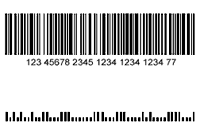
Bindery:
The finishing department, which performs operations on the printed product after it has been printed. The bindery operations are as follows: Folding, Binding, Stitching, Scoring, Perforation, Die Cutting, & Envelope Converting.
Binding:
Different methods used to secure loose pages in a book is called binding. Saddle stitch is an example of binding.

Bleed:
Printed colors that extend past the edge of a page. To cut the job to its actual size the processor has to make sure the job gets printed with 1/8 of an inch bleed some jobs may require more than that. For example if the job is a business card (3.5" x 2") the file size with bleed would be (3.625" x 2.125").
Borders:
An outline around graphics, text or edge of a sheet.
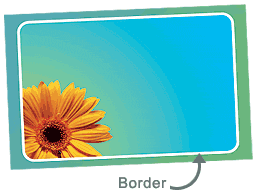
Brightness:
Refers to the percent of light reflected back from a sheet of paper as measured by a light meter reading. Contrast is reduced and highlights are not as strong when paper with a lower brightness is used for a printed piece. Depending on paper brand, the papers have different brightness grades, for example Tango has 91 brightness, Balboa ha 90 brightness.
Bulk Mail:
Standard Mail or Third Class Mail.
C1S paper:
Paper coated on one side.
C2S paper:
Paper coated on both sides. Our 14pt and 16pt paper are examples of C2S. (AQ Coating or UV Coating are separate options and are not effected by this)
Card Stock:
Also called cover stock. Mostly heavyweight papers are called cards stock. The thickness of card stock is indicated with point sizes such as 14pt, 16pt. Some people will also refer to 100lb gloss cover as a card stock.
Carrier Route:
The address to which a carrier delivers mail. In common usage, carrier route includes city routes, rural routes, highway contact routes, post office box sections, and general delivery units.
CMYK:
The primary colors used in 4-color printing. CMYK are used to reproduce full color on the printed sheet. CMYK also called PROCESS COLOR
C: Cyan (Blue)
M: Magenta (Red)
Y: Yellow
K: Key (Black)
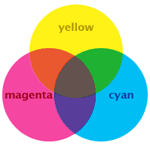
Coating:
The mixture of clay materials that are applied to paper to improve the smoothness of the paper's surface and improve ink holdout during the printing process. Examples are Aqueous coating (AQ) and UV coating. UV coating adds a gloss finish to the product and also improves the vibrancy of the printed colors. Spot-UV can be applied to selected portions of the piece, while keeping the rest a matte finish.
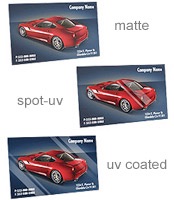
Coding Accuracy Support System (CASS):
A service offered to mailers, service bureaus, and software vendors that improves the accuracy of matching to delivery point codes, ZIP+4 codes, 5-digit Zip Codes, and carrier route codes on mail piece. CASS provides a common platform to measure the quality of address matching software and to diagnose and correct software problems.
Collecting:
Prepress Department that imposes multiple jobs of the same type in a press layout, called a batch. Collecting is responsible for creating schedules that meet production deadlines and satisfy job turnarounds.
Collect on Delivery (COD):
A service for mailers who need to mail an article for which they have not received payment. The amount due the sender is collected from the addressee and the carrier returns the amount due to the sender.
Color Types
4/4 (4 over 4) - 2 sided - full color on front and on back
4/1 (4 over 1) - 2 sided - full color on front, black on back
4/0 (4 over 0) - 1 sided - full color on front
5/0 (5 over 0) - 1 sided - full color + spot color on front
5/1 (5 over 1) - 2 sided - full color + spot color on front, black on back
4/5 (4 over 5) - 2 sided - full color on front and full color + spot color on back
5/4 (5 over 4) - 2 sided - full color + spot color on front and full color on back
5/5 (5 over 5) - 2 sided - full color + spot color on front and on back
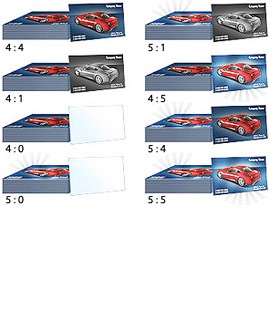
Color Proof / Match Print:
An image, created by using color inks. Showing what the final printed product will look like. Color proofs are typically 80%-85% match with the final product.
Consecutive Numbering:
Numbering a form, or a series of printed material where the number changes sequentially from one to another. Example, if the first one has number 201, the second will get 202, the third would be 203 and so on.
Crop Marks (Guide Marks):
Lines printed in the margin of sheet that indicates to the cutter and bindery where the finished product should be trimmed. They are also used to show what part of a photo should be used and what part should be cropped off.

Die Cutting:
A specific shape like circle, star, etc (any design that cannot be done by a straight cut) which is cut by a metal blade. Door hangers are a popular product which requires die cutting.

Direct Mail:
Another name for advertising mail sent to targeted markets. It can be any mail class, but it is usually Standard Mail.
Dots Per Inch (dpi):
A measurement of resolution of input, output and display devices. 300 dpi means that when printed, each square inch of your image will contain 90,000 pixels (dots), the higher the dpi (the more pixels per inch) the more crisp the printed image will be. Our electronic (digital files) have to have a resolution of at least 300 dpi. Anything less than that is considered as low resolution and may appear blurry when printed.
Embossing:
A process of imprinting an image by applying pressure to the back side of a material to change the surface, giving it a three dimensional or raised effect. Embossing can be referred to as raised lettering.

Finished Size / Trim Size:
The size of a printed product after all production operations have been completed.
Finishing:
Operations to a document after it has been printed. The finishing operations could include bindery work such as, folding, trimming, binding, die cutting, inserting or any post press process that must be completed.
Flat Size:
The size of a printed product after printing and trimming but before any finishing operations that affect its size, such as folding.
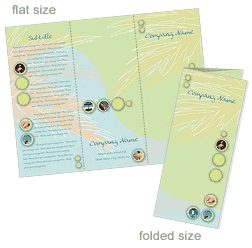
FM Screening:
Historically printers have adopted and used AM or Amplitude Modulated screening which is a halftone screen arranged on a grid. Larger dots render dark tone values while smaller dots are used for lighter values. Viewed from a distance these dots create the illusion of continuous tone reproduction. Common screen rulings range up to 200 lpi. Even though AM screening is a common method for many printers nationwide, there is a better and higher quality method for screening and producing better work.
We do our best to maintain the fidelity of your creative intent through the complex process of reproduction in print. While printing 200 lpi may be satisfactory, we have gone one huge step further with the adoption of Staccato (or FM) screening method that brings near photographic quality. Staccato eliminates halftone screen angles, rosettes, and screening moiré while preserving the desirable details in your artwork. Our Staccato screening process employs 20 micron dot size which is equivalent to 500 lpi.
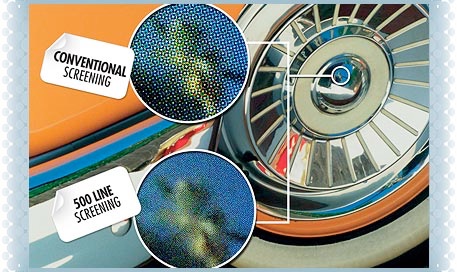
FM screening is a unique and accurate process that uses a special arrangement of dots in a random pattern with no set frequency or angle. Dark tones are rendered with higher frequency dots and light tones with fewer dots. Therefore industry experts refer to it as Frequency (quantity) Modulated screen or simply FM screen. Random distribution of the dots eliminates screening moiré, subject moiré and AM rosettes. The microdot structure leads to photographic quality, greater tonal stability on press, a larger color gamut, and reduced ink usage compared to AM or XM screens.
Staccato is a standard with Dean Huff. It gives us the ability to produce high quality images that exhibit fine detail without visible dots, rosettes, screening moiré, gray level limitations or abrupt jumps in color tone. Typical printers use a screen frequency of 175-200 lines per inch. Staccato implementations resolve texts and images to 20 microns, equivalent to 500 lines per inch. Staccato improves color and halftone stability on press, making it a perfect complement to consistent high quality sheet-fed printing. When imaging, Staccato screening delivers unmatched quality, a practical tool for customers.
Increased stability means more vibrant, more predictable color.
Staccato screening brings tonal and color stability to the pressroom by reducing variations in dot gain caused by changes in solid ink density, wet trap, and color contamination from paper. Unique halftone patterns are used in each separation to minimize dot-on-dot printing. The on press stability of Staccato makes it particularly effective for replacing custom colors with process screen builds.
Foil:
The application of metallic or holographic, colored foil on paper using a heated die. The foil is adhered to the surface leaving the design of the die on the paper. Our foil stamping adds a custom touch to your printed product by applying a thin film of metal to paper that creates a high grade, eye-catching result.
Folding:
The process of bending printed sheets in a specific area. Folding is one of our popular bindery jobs.
4-Panel Roll Fold:
A type of fold where the piece is folded inward at one end and then folded inward again one or more times. It is as if you are rolling the piece up.

Accordion Fold:
A sheet which has been printed on only one side then folded twice in right angles to form a W-shaped four page uncut section.

Double Gate Fold:
Single gate fold, with an additional fold on the center.

Double Parallel Fold :
A type of fold where the piece is folded in half and then folded in half again. The folds are parallel to each other. Also known as a quarter fold.

French Fold (quarter fold):
A sheet which has been printed on one side only and then folded twice at right angles to form a four page uncut section.

Gate Fold:
When both sides of an oversize page fold into the gutter in overlapping layers.

Half Fold:
Is fold in half.

Half-Tri Fold:
A sheet is folded in half and then tri-folded.

Tri Fold:
A fold where a three panel piece has both side sections folded inward, one on top of the other each section is approximately 1/3 the length of the piece. Also known as a C-fold or letter-fold.

Z Fold:
A paper fold represented by back and forth folds into three panels.

Full Bleed:
Printing that goes to the edge of all four sides of the page.
Gloss Finish:
A coating on paper that provides a higher reflection of light, which results in a shiny appearance. Gloss coatings reduce ink absorption, which allows excellent contrast and color definition.
Gloss Paper:
Paper with a gloss finish, usually used for higher quality printing. Examples are 100lb gloss book, and 100lb gloss cover.
Gray Scale:
Gray tones ranging from white to black. Gray scale refers to black and white printed material.
Grippers:
Metal finger like clamps that grab the paper to pull it through the press as the sheet is being printed.
Hairline:
The thinnest possible line or space that is visible.
Head to Head:
Printing on the front and back of a sheet is setup so that the top of both sides is printed at the same end of the sheet. You would turn the sheet like the page of a book to read the reverse side.
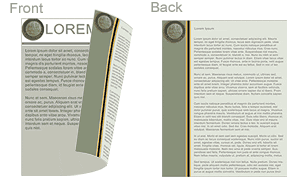
Head-to-Toe:
Printing on the front and back of a sheet so that the tops of each side are printed at opposite ends from each other. The top of one side is opposite the bottom of the other. You would turn the sheet over from top to bottom to read the reverse side. Also referred to as head-to-tail or tumble.
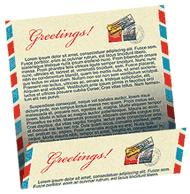
Hickey:
A spot on a printed sheet that appears as a small white circle with ink in the center, caused by particles such as dirt, dust, or bits of paper.
Imprinting:
The printing of new copy (text) on a piece that is already printed. Examples of imprinting are ink-jetting addresses on postcards after the actual card has been printed. Please note that we DO NOT imprint or inkjet on any paper with flood UV or AQ Coating.
In House:
When a production process for a printed product is done within a facility and is not sent to an outsider, also referred to as in plant.
Ink Jet:
A printing technology in which liquid ink is sprayed through tiny nozzles onto the paper in a pattern of dots, forming the image on the paper. Jobs with AQ or UV coating cannot be ink jet printed.
Insert:
A letter, card, or similar item placed inside another mail piece (host piece).
Landscape:
Printing a page so that when positioned for reading the width is greater than the height.
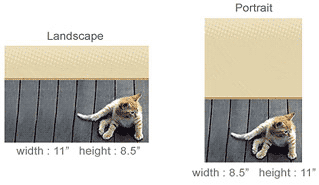
Line-of-Travel (LOT) Sequence:
A sequence required for some Enhanced Carrier Route and carrier route rates in which mail pieces are arranged by ZIP+4 codes in the order in which the carrier serves the route. The mail pieces are sequenced in delivery order.
Line Screen:
A transparent screen which has been etched with fine lines. It is used to convert a picture or photograph into a halftone dot pattern so that can be printed.
We do our best to maintain the fidelity of your creative intent through the complex process of reproduction in print. While printing 200 lpi may be satisfactory, we have gone one huge step further with the adoption of Staccato (or FM) screening method on 90% of our offset printed products that brings near photographic quality. Staccato eliminates halftone screen angles, rosettes, and screening moiré while preserving the desirable details in your artwork. Our Staccato screening process employs 20 micron dot size which is equivalent to 500 lpi.
Make-Ready:
1.The process of setting up and adjusting a printing press for a particular ink, paper and specifications prior to printing. This includes adjusting the infeed, grippers and guides, adjusting ink for proper coverage, registering copy, and matching the printed piece with the proof to be sure everything is correct. Also referred to as set up.
2. The paper used while making all the necessary adjustments before printing the actual run. Also referred to as set up.
Margin:
The non-printed areas around the image area of a page.
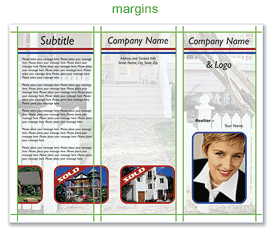
Matte Finish:
A coated paper finish that is flat, not shiny like a gloss, but still keeps much of the ink from being absorbed by the paper and produces an excellent image.
Offset Printing:
The transfer of an inked image from a plate to a blanket cylinder, which in turn transfers the image to the printing material as it passes between the blanket and the impression cylinder and pressure is applied. Also referred to as offset lithography.
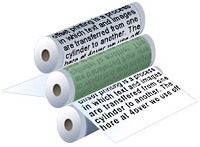
Open End Envelope:
An envelope with an opening along its short dimension.
Open Side Envelope:
An envelope with an opening along its longest dimension.
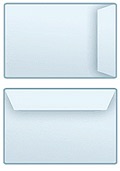
Out of Register / Off Register:
When an image is not printing in the exact location that it is suppose to. When printing more than one color, if the colors do not line up properly, they are out of register.

Output:
Sending information from a computer to a printing device to produce a printed page is called output.
Overprinting:
Printing an image over an area that has already been printed. In printing process colors, one process color is printed over another creating a secondary color, which is a combination of two primary colors. Sometimes in the files that customers send us there will be overprinting issues. Such as type or logos not printing. Customers should be aware that we do not check for this and their overprinting situation must be evaluated before sending the files to us.
Overruns / Overs:
The quantity of items produced over the quantity that was originally ordered. Also referred to as any paper spoiled in the process of printing. For example if our batch run requires 1000 sheets we may overrun 150-200 sheets.
Pantone Matching System (PMS):
The name for an ink color matching system used to compare, match and identify specific colors. To do so we use a pantone book.
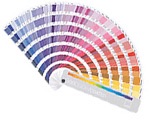
Paper Grain:
The direction in which the fibers line up during the manufacturing process. It is easier to fold, bend, or tear the paper along the same direction of the fibers. Cut sheet laser printers generally use long grain paper in which the grain runs parallel to the long side of the paper, resulting in better performance through the laser printer.
Perfector:
A printing press that can print on the front and the back of the paper in one pass through the press.
Perfecting:
The process of printing both sides of a sheet of paper in the same pass through the press.
Perforation:
Creating a series of holes so that the paper can be torn more easily along the line that is formed. Postage stamps and tear-off cards are common products that require perforation.
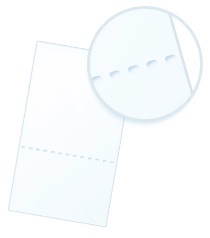
Pixel:
The smallest unit of a digitized image created by a digital device, such as a computer, camera, or scanner. Pixel is short for "picture element." The more pixels per inch the better the resolution. On computer monitors, the display is divided into rows and columns containing thousands or millions of pixels. Each pixel is composed of three dots representing the three color channels of red, green, and blue light that are necessary for creating a color image on computer monitors and television screens. Because of their small size, the pixels appear to merge, simulating a continuous tone image, but when magnified they appear to be tiny square blocks of light, as shown in the illustration.
Plate:
A metal or paper light-sensitive sheet that holds an image that has been photographically produced. During the printing process, the image area picks up ink, which is then transferred to a blanket and then to paper.
Postage:
Payment for delivery service that is affixed or imprinted to a mail piece, usually in the form of a postage stamp, permit imprint, or meter stamp.
Permit:
Authorization required to mail without affixing postage. A postage imprint, also referred to as an indicia (The imprinted area in the upper right corner of the mail piece that indicates postage payment), is used instead. An advance payment is made to the post office and postage payment is deducted from that deposit.
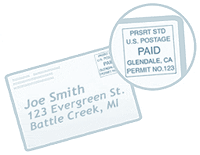
Presentation Folder:
We offer different kinds of presentation folders, Inner pocket with round cut corner: (1 or 2, left & right pockets are optional) Inner pocket with straight cut corner: (1 or 2, left & right pockets are optional) Business card slit, left or right is also optional.
Presort:
The process by which a mailer groups mail by ZIP Code so that it is sorted to the finest extent required by the standards for the rate claimed. Generally, presort is performed sequentially, from the lowest (finest) level to the highest level, to those destinations specified by standard and is completed at each level before the next level is prepared. Not all presort levels are applicable to all mailings.
Press:
Machine used to print batches.
Press Check:
Printed sheets from the press that are pulled once all the makeready has been completed. The sheets are checked for quality and accuracy before authorization is given to go ahead with the full production run. Sheets may be pulled throughout the run to do press checks to assure that quality is being maintained. At this time, we DO NOT do press checks for customers.
Press Proof:
A proof that is produced on the press using the inks and paper specified for that order. At this time, we DO NOT do press proofs for customers.
Press Run:
The total quantity of pieces printed during one printing.
Price Break:
The order quantity level at which the price of the paper or printed material goes down.
Prinergy:
One of two software systems that is use to send batches to the plating machine. When using Prinergy, batches will be sent to the Creo CTP (computer to plate).
Processing:
The department in charge of making customers' files "print ready".
Proofs:
A copy of the artwork representing the finished product. It is used for review and approval.
Proofread:
Checking a proof for errors or discrepancies from the original copy.
Punching:
Drilling of holes through a stack of paper. We use hole punching if a customer wants to have that on any printed piece. Popular sizes are 1/8" & 5/16".
Quotation:
A price, given by the printer or distributor, based on the specifications supplied for that product.
Register Marks:
The printed marks used to align color separations for printing so that each color registers with each other.
Resolution:
The measurement of output quality expressed in pixels (dots) per inch on a computer monitor or dots per inch on printed media. For example, a monitor displaying a resolution of 800 by 600 refers to a screen capable of displaying 800 pixels in each of 600 lines, which translates into a total of 480,000 pixels displayed on the screen. When referring to printed media, a 300 dpi (dots per inch) printer for example, is capable of outputting 300 dots in a one-inch line, which means that it has the ability of printing 90,000 distinct dots per square inch (300 x 300).
RGB:
The additive primary colors, red, green and blue, used to display color in video monitors. Printing with a file in RGB color mode will produce a washed out appearance.
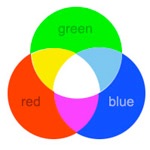
Rotation:
The turning or positioning of text or an image at different degrees of orientation on a page.
Round Cornering:
Using a machine to die cut the corners of forms, cards and books to create a rounded corner.
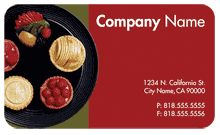
Saddle Stitching:
The method of binding the pages of a section where the folded pages are stitched through the fold from the outside, using a wire staple (stapling).
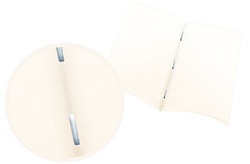
Samples:
A small quantity of the actual job.
Scoring:
A crease applied, in a straight line, to a sheet of paper to allow it to fold easier and more accurately.
Score in half, is the most popular.

Set Up:
1.The process of setting up and adjusting a printing press for a particular ink, paper and specifications prior to printing. This includes adjusting the infeed, grippers and guides, adjusting ink for proper coverage, registering copy, and matching the printed piece with the proof to be sure everything is correct. Also referred to as make ready.
2. The paper used while making all the necessary adjustments before printing the actual run. Also referred to as make ready.
Silver:
Spot color, pantone metallic 877.
Skid / Pallet:
A wooden platform used to hold stacks of paper or cartons. Used to store or ship materials or finished products.
Sleeve:
A paperboard jacket that fits over the four sides (top, bottom, and two parallel sides) of a letter tray in order to keep the mail inside the tray from falling out.
Slitting:
Cutting paper by the use of a cutting wheel. Paper may be slit into smaller sheets or a web of paper may be slit into narrower rolls.
A slit can also refer to cuts made that do not divide a sheet. For example, on a presentation folder smaller diagonal slits can be made on the pockets where business cards can then be displayed.
Spiral Binding:
Book binding that consists of a spiral wire or plastic that is wound through holes. Also referred to as coil binding.
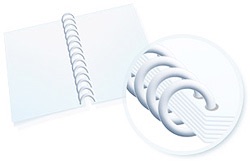
Spot Coating / Spot UV:
Coating paper only in specific areas as opposed to all over coating. In a Spot UV job the job gets a UV coating in only specific areas and does not get any coating in any other places. Spot UV can be referred to as spot varnish.
Spot Color:
Printing with one or more solid colors, generally metallic or ink is used with the addition of other colors. It is used to add highlight and add color to a printed product without having to print with four-color process.
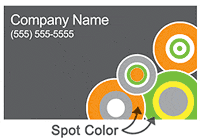
Stochastic Screening:
Images are converted digitally into screens made up of very small dots which are equal in size, but of variable spacing. The variable dot pattern eliminates many of the moiré patterns and allows for more than four colors to be used to represent an image. This is the primary aspect of high-fidelity printing.
We do our best to maintain the fidelity of your creative intent through the complex process of reproduction in print. While printing 200 lpi may be satisfactory, we have gone one huge step further with the adoption of Staccato (or FM) screening method that brings near photographic quality. Staccato eliminates halftone screen angles, rosettes, and screening moiré while preserving the desirable details in your artwork. Our Staccato screening process employs 20 micron dot size which is equivalent to 500 lpi.
Stripping:
1.To assemble and combine film or negatives to produce the final film for plate making. This process is now done electronically by many companies, bypassing the manual process altogether.
2. In reference to labels it is the removal of the matrix or waste material from around a pressure sensitive label after it has been die cut.
Swatch Book:
A booklet containing samples of paper or ink colors.
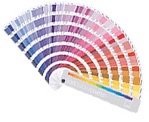
Template:
A preset model that acts as a structure for setting up a similar product.
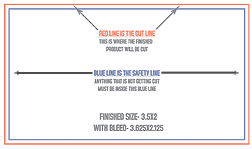
Tray:
A container used in postal facilities to hold letters and First-Class Mail flats. It is used as a basic unit of mail quantity for purposes of preparing mail to a qualify for discounted postage rates. Also see full flat tray, full letter tray, less-than-full tray, and overflow tray.
Trim:
1. The process of cutting the product to its finished size. The excess that is cut off is also referred to as the trim.
2. Combining various roll sizes to be slit from a full width roll from the paper machine so that an acceptable percentage of the salable width will be used.
Turnaround Time:
The accumulated time between receipt of an order and completion of the finished product. We offer different types of turnaround depending on the product, we have Same Day, Next Day, 2-4 days, 5-7 days and 7-9 business days turnaround.
Typesetting:
The process of converting text into type used for printing.
UV:
Ultra Violet. The part of the spectrum where the wavelength of light is shorter than the wavelength of visible light.
UV Coating:
A liquid coating applied to the printed piece, which is then bonded and cured with ultraviolet light. This coating is used to provide a protective coating to the printed image. Please note that you CAN NOT write or imprint on a uv coated jobs.
Varnish:
A thin, liquid protective coating, either matte or glossy, that is applied to the product. It adds protection and enhances the appearance of the product. It can be applied as an all over coating or it can be applied as a spot coating.
Vendor:
The provider of a product or service. Also referred to as supplier.
Window Envelopes:
An envelope with a die cut opening that is intended to have information show through from the piece inside the envelope.
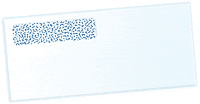
Work and Tumble:
A printing method where different pages are assembled so that they are on one plate. One side is printed and the sheet is turned from front to rear so that you are using the opposite edge as the gripper edge and then the second side is printed. The product is then cut apart to make two finished items.
Work and Turn:
A printing method where different pages are assembled so that they are on one plate. One side is printed and then the sheet is turned over so that you are using the same gripper edge and then the second side is printed. The product is then cut apart to make two finished items.
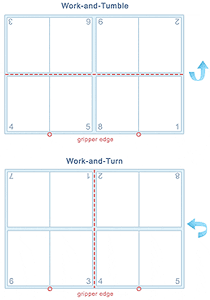
Zip:
Zipping is a way to compress electronic files A compressed file is considered "zipped."
ZIP Code:
A system of 5-digit codes that identifies the individual post office or metropolitan area delivery station associated with an address. ZIP+4 is an enhanced code consisting of the 5-digit ZIP Code and four additional digits that identify a specific range of delivery addresses.
ZIP+4 Code:
A nine digit numeric code composed of two parts: (a) the initial code: the first five digits that identify the sectional center facility and delivery area associated with the address, followed by a hyphen; and (b) the four-digit expanded code: the first two additional digits designate the sector (a geographic area) and the last two digits designate the segment (a building, floor, etc.)
ZIP+4 barcode:
A nine-digit POSTNET barcode consisting of 52 vertical bars. Also see Postal Numeric Encoding Technique.
printing glossary

















